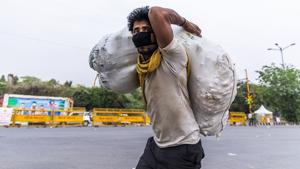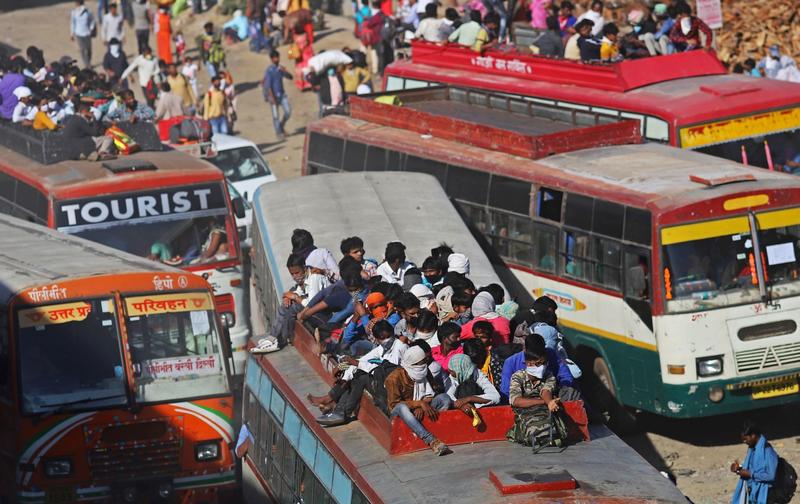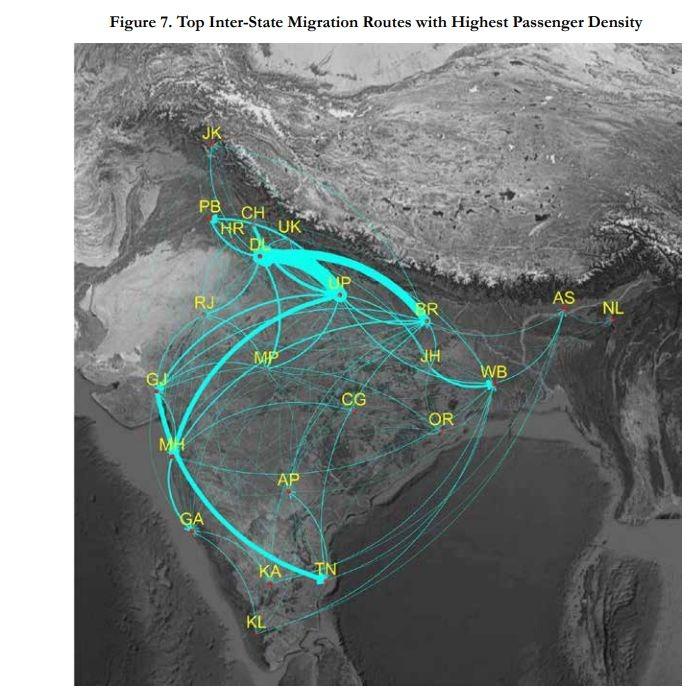 A man wearing a protective mask carries a sack of vegetables at the Okhla Agricultural Produce Market Committee wholesale market during a lockdown imposed due to the coronavirus in New Delhi, India on April 15, 2020. (PHOTO / BLOOMBERG)
A man wearing a protective mask carries a sack of vegetables at the Okhla Agricultural Produce Market Committee wholesale market during a lockdown imposed due to the coronavirus in New Delhi, India on April 15, 2020. (PHOTO / BLOOMBERG)
Migrant workers fled India’s cities en masse last month after Prime Minister Narendra Modi’s lockdown left them suddenly unemployed. Now the employers that let them go may need to offer big incentives to lure them back.
Sontosh Das, 24, lost his job driving for a family of doctors in India’s capital of New Delhi and fled to his village in West Bengal some 1,400 kilometers away, just before the lockdown took effect on March 24. Now home in eastern India, he said he’d rather try his luck with the government’s rural job-guarantee program than risk being left with nothing once again.
ALSO READ: India 'partially lifts malaria drug export ban' on Trump call
Tens of thousands of workers who returned to villages are now similarly weighing whether to return at the end of the lockdown, which Modi this week extended to May 3
“After Modi ji’s lockdown, we’re scared of returning,” Das said over a crackling phone line. “During tough times, only family comes to help.”
Tens of thousands of workers who returned to villages are now similarly weighing whether to return at the end of the lockdown, which Modi this week extended to May 3. Companies are already reporting labor shortages at ports and factories, potentially exacerbating an economic slowdown. Goldman Sachs Group Inc. this month slashed its annual growth forecast for India to the slowest pace since 1992, around when a balance of payments crisis brought down the sitting government.
Automobile makers, which include the local units of Nissan Motor Co., Ford Motor Co. and Suzuki Motor Corp., are discussing potential labor shortages after India lifts its lockdown, according to people familiar with discussions. Jewelers, India’s second-largest export sector, see production suffering for at least two months, said N. Anantha Padmanaban, chairman of the All India Gem and Jewellery Domestic Council.
Real estate developers, an industry that includes investors Blackstone Group Inc. and Brookfield Asset Management Inc., predicted more incomplete apartments and office buildings that could ripple through the financial sector in the coming year as a surge in defaults. Companies such as Jindal Steel Ltd. are facing a shortage of crane operators at ports.
‘Unprecedented Hardship’
The labor shortages could persist for as long as six months before broader unemployment becomes a bigger concern, said Sujan Hajra, Mumbai-based chief economist at Anand Rathi Financial Services Ltd. About 20 percent of India’s workforce comprises migrants journeying from another state, while a larger share is made up of people who travel from different parts of the state where their workplace is located, he added.
“The unprecedented hardship faced by migrant workers since the outbreak of Covid-19 might result in fear psychosis,” Hajra said, predicting a worsening of India’s “already precarious employment situation.”
Modi has apologized for the hardship caused by the sudden lockdown - announced at dinnertime March 24 and brought into force at midnight - which denied as many as 100 million workers the chance to collect their pay and triggered the biggest forced migration since the partition of India in 1947. Yet, for the hundreds of thousands of laborers who began trudging back to their villages after being rendered unemployed and homeless, anger against Modi will depend on how long the pain lingers.
“Modi’s government has been clever about putting the onus of safety and health on the citizens and not on the state,” said Yamini Aiyar, president at the Centre for Policy Research in New Delhi who formerly worked with the World Bank on rural development.
If fatalities stay low, “the Modi government could spin this as a victory - say ‘yes, you faced hardships but at least people stayed alive,’” she said. “But if the numbers grow, their handling will be questioned along with the bungling in the economic sphere, which is significant and severe.”
The government is aware the country will need to address labor shortages to restart the economy, Nitin Gadkari, minister of roads and small and medium scale enterprises, said in an interview.
 Migrant workers and their families sit atop a bus on the outskirts of Delhi during a lockdown imposed due to the coronavirus in Lalkuan, Uttarakhand, India on March 29, 2020. (PHOTO / BLOOMBERG)
Migrant workers and their families sit atop a bus on the outskirts of Delhi during a lockdown imposed due to the coronavirus in Lalkuan, Uttarakhand, India on March 29, 2020. (PHOTO / BLOOMBERG)
India will allow makers of information technology hardware, farmers and industries in rural areas to resume operations after April 20, the Ministry of Home Affairs said in a statement on Wednesday. It will also lift restrictions to allow e-commerce companies, goods movement by roads, as well as restart port and air cargo operations.
Seasonal Labor
India’s internal migration flow changes with the seasons, with millions of workers heading to cities for most months of the year to build cars, load ships, or clean houses, before going home in time for the village harvest. Bihar, a state due to hold elections this year and home to India’s second-highest migrant labor population, will be worst hit due to the reverse migration, economist and workers’ rights activist Jean Dreze wrote in the Outlook magazine.
Goldman forecasts India’s gross domestic product will grow 1.6 percent in the year that started April 1, the slowest pace since 1992, around the time when a balance of payments crisis brought down the sitting government and led to the creation of a new administration focused on economic reform rather than political in-fighting. While India’s economic fundamentals are far stronger today than two decades ago, the nation’s poorest citizens have been directly hit for the second time since 2016, when Modi abruptly invalidated almost all bank notes in a similar late night edict aimed at combating corruption.
Yet, unlike during demonetization when workers felt the rich man suffered more, the virus lockdown hurts mostly the poor, said Chinmay Tumbe, an Ahmedabad-based economist with the Indian Institute of Management and author of ‘India Moving: A History of Migration.’ He sees closer parallels with the Bombay bubonic plague of 1896, when migrants fled the city (since renamed Mumbai) and locals perceived the colonial government’s handling of the outbreak as excessive, leading to the slaying of a British bureaucrat that foretold the start of militant nationalism in India.
 (BLOOMBERG GRAPHIC)
(BLOOMBERG GRAPHIC)
Tumbe predicts the coronavirus crisis will force businesses to offer incentives to retain workers for coming months, just like the 1896 exodus shifted bargaining power to labor from capital at the turn of the century. “We will see tremendous labor shortages,” he said. “There will be a psychological impact.”
‘Prolonged Recession’
Any meaningful stimulus would need a minimum 6 trillion rupees (US$79 billion) compared with the 600 billion rupees cash Modi’s government pledges to transfer to the poor, estimates Palaniappan Chidambaram, a leader of the opposition Congress party and India’s former finance minister who presided over the country’s response to the global financial crisis of 2008/09. A “deep and prolonged recession” awaits sectors such as agriculture that are dependent on migration, Chidambaram said by email.
While Indian policy makers are treating the issue purely as an economic problem, they must adopt an anthropological approach and understand the workers’ desire to be with their families in a crisis, according to Sugandha Nagpal, an assistant professor at Jindal School of International Affairs. To encourage the workers to return once the crisis abates, authorities paradoxically need to escort them home now after speedy tests to ensure they aren’t carriers of the virus, she recommends.
Migrant workers on Tuesday swarmed out of a camp created for them in Mumbai, demanding to go home after a rumor went around that India is resuming railway services. More than 600,000 are currently housed in the city, according to local leaders, who blame Modi’s federal government for not allowing them a passage back to their states.
READ MORE: India bans all exports of Trump's 'game changer' virus drug
Before Das was allowed into his village in Uttar Dinajpur, West Bengal, the headman and a doctor checked on him. Then neighbors cloistered his family within their house until convinced they were healthy. The ancestral rice farm is too small to sustain Das, his parents and two brothers, so Das’s father runs a stall selling paan - a chewy combination of betel leaf, areca nut and tobacco - to supplement income. In New Delhi, Das would earn US$240 a month, a decent wage in a nation where more than 80 percent of workers earn less than half.
“My mother insists we should stay back home, she says we don’t need so much money to live on,” Das said. “No one knows how long this madness will last but we know that nothing will remain the same after this.”


